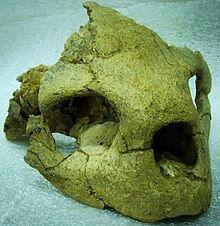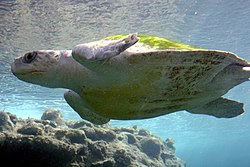| Pacifichelys | |
|---|---|
 | |
| Skull of Pacifichelys urbinai | |
| Scientific classification | |
| Domain: | Eukaryota |
| Kingdom: | Animalia |
| Phylum: | Chordata |
| Class: | Reptilia |
| Order: | Testudines |
| Suborder: | Cryptodira |
| Superfamily: | Chelonioidea |
| Family: | Cheloniidae |
| Genus: | † Pacifichelys |
| Type species | |
| Pacifichelys urbinai Parham and Pyenson, 2010 | |
| Species | |
| |
| Synonyms | |
| |
Pacifichelys is an extinct genus of sea turtle from the Middle Miocene of Peru (Pisco Formation) and California (Temblor Formation). [1] [2] It was first named by James F. Parham and Nicholas D. Pyenson in 2010, and the type species is Pacifichelys urbinai from Peru. [2] A second species, P. hutchisoni, was reassigned from the genus Euclastes . It is known from the Miocene of California. Like the living Ridley and loggerhead sea turtles, Pacifichelys was durophagous, consuming hard-shelled organisms with crushing jaws. [2]
